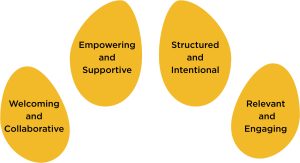
The four gold shapes above the Foundations circle (the “toes”) of the model represent the four Dimensions of Teaching for Learning Effectiveness.
The Dimensions are thematically discrete but interrelated areas of Teaching for Learning Effectiveness that form the functional basis of the TFELT system of teaching evaluation. Each dimension is an aspect of our students’ experience in their learning environment.
Relationship of the Dimensions to the Foundations
How are the “toes” connected to the rest of the “paw?”
The MU model adopted after the TFELT report and proposal of June 4, 2021 recognizes four Foundations establishing that Effective Teaching is inherently:
- Evidence-Based
- Student–Centered
- Reflective
- Continuously Developing
This means that educators should consider, in their teaching work and subsequent reflection, whether their approaches to develop proficient practice in a given dimension are grounded in the Foundations; that is, are their professional practices regarding that dimension evidence-based, student-centered, reflective, and continuously developing.
Teaching for Learning Effectiveness and the Dimensions
Each of the Dimensions within the MU model of Teaching for Learning Effectiveness represents not only an important response students should have to their instruction and learning environment, but also a variety of related research-supported practices for course design, pedagogy, class management and class-related communication. The outcomes of using professional practices that advance each Dimension should, ideally, result in effective teaching for learning that reaches all students. The importance of Teaching for Learning Effectiveness practices within each Dimension is reflected in each piece of the multi-measure approach to teaching evaluation proposed by TFELT.
Defining the Four Dimensions
The following descriptions of each Dimension come from the TFELT proposal. In these descriptions, “Key terms” refers to descriptive terms that were generated through TFELT’s examination of relevant research literature and iterative brainstorming and refining during MU community workshop activities during September and October 2019. For more information on this process, please see the “TFELT Process to Determine Definition and dimensions of Effective Teaching” section on the task force’s online archive of in-progress work.
Click on the link provided for each dimension for additional explanation, examples, and relevant scholarship in the area.
Welcoming and Collaborative means that the instructor welcomes and actively includes all students and perspectives in the learning environment. Students in the course collaborate with the instructor and other students.
Key terms for this dimension include: Interactive, Dialogue, Creative, Relationships, Respectful.
Empowering and Supportive means that the instructor invites students to set and reach their learning goals. The instructor supports student success through giving constructive feedback, mentoring, advising, and guiding students while listening and responding to student needs.
Key terms for this dimension include: Professional, Encouraging, Inspiring student action, Approachable
Structured and Intentional means that the instructor plans the course well, describes the course clearly, and aligns learning objectives, learning activities, and assessment. The instructor clearly communicates these expectations and what students need to do to meet them.
Key terms for this dimension include: Clear Communication, Outcome based, High Standards, Accessible, Scaffolded
Relevant and Engaging means that the instructor helps students discover the relevance of the subject matter to their lives and future professions. The instructor engages students in active learning to produce authentic and creative works.
Key terms for this dimension include: Active Learning, Collaborative, Modeling Disciplinary Process, Metacognition, Culturally knowledgeable
The Dimensions’ Role in Teaching Evaluation
As described elsewhere on this website, these four dimensions provide a common vocabulary and conceptual framework that shapes how Teaching for Learning Effectiveness is evaluated at the University of Missouri, including:
- Student Feedback: Construct means from the data collected through the end-of-semester student feedback survey align with the four Dimensions.
- Peer Review: The categories of rubric items on the formative checklist and summative rubric for peer review observations are constructed based on the four Dimensions.
- Self-Reflection: One of the items on the reflection form provides faculty an opportunity to choose and examine how they approach a specific Dimension in their teaching.